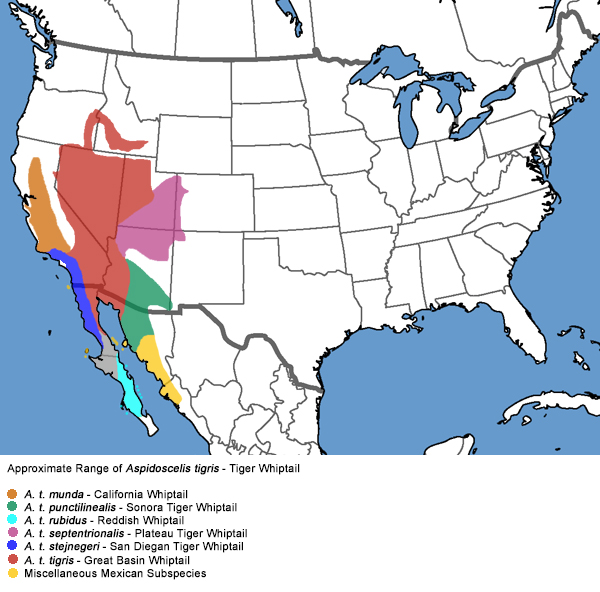Tiger Whiptail - Aspidoscelis tigris
Great Basin Whiptail - Aspidoscelis tigris tigris
(Baird and Girard, 1852)(= Cnemidophorus tigris tigris)
Description • Taxonomy • Species Description • Scientific Name • Alt. Names • Similar Herps • References • Conservation Status
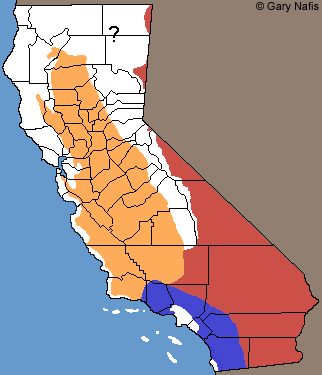 Red: Range of this subspecies in California
Red: Range of this subspecies in CaliforniaAspidoscelis tigris tigris - Great Basin Whiptail
Range of other subspecies in California:
Dark Blue: Aspidoscelis tigris stejnegeri -
San Diegan Tiger Whiptail
Orange: Aspidoscelis tigris munda -
California Whiptail
Click on the map for a topographical view
Map with California County Names
 |
|||||||||||||||||||||||||||||||||||||||||||||||||||||||
| Adult, Kern County | |||||||||||||||||||||||||||||||||||||||||||||||||||||||
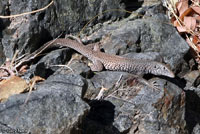 |
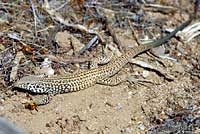 |
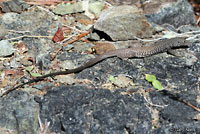 |
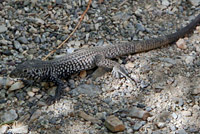 |
||||||||||||||||||||||||||||||||||||||||||||||||||||
| Adult, Inyo County | Adult, San Diego County | Adult, Inyo County | Adult, Inyo County | ||||||||||||||||||||||||||||||||||||||||||||||||||||
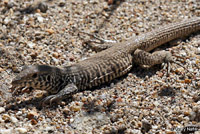 |
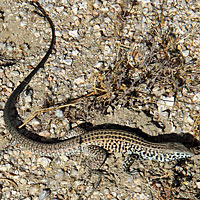 |
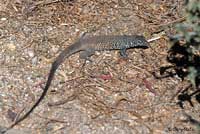 |
 |
||||||||||||||||||||||||||||||||||||||||||||||||||||
| Adult, San Diego County | Adult, Kern County | Adult, San Diego County | Adult, Kern County | ||||||||||||||||||||||||||||||||||||||||||||||||||||
 |
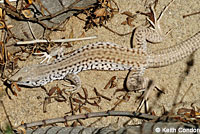 |
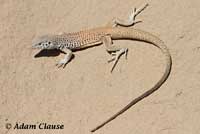 |
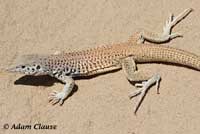 |
||||||||||||||||||||||||||||||||||||||||||||||||||||
| Adult, San Bernardino County © Jeff Ahrens |
Adult with a faded pattern, Imperial County © Keith Condon | Adult with pink and tan coloration, Imperial County © Adam Clause | |||||||||||||||||||||||||||||||||||||||||||||||||||||
 |
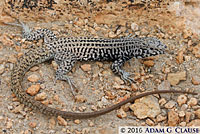 |
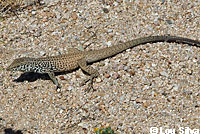 |
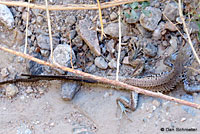 |
||||||||||||||||||||||||||||||||||||||||||||||||||||
| Adult male, Mono County © Adam Clause |
Adult male, Mono County © Adam Clause |
Adult, Kern County © Lou Silva | This Great Basin Whiptail from Riverside County has an abnormal forked tail, probably resulting from an injury. © Dan Schroeter |
||||||||||||||||||||||||||||||||||||||||||||||||||||
 |
|||||||||||||||||||||||||||||||||||||||||||||||||||||||
| Adult, San Bernardino County © Mike Ryan | |||||||||||||||||||||||||||||||||||||||||||||||||||||||
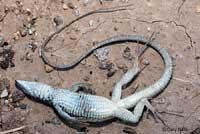 |
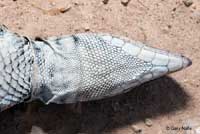 |
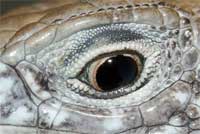 |
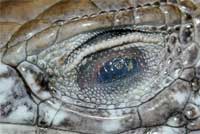 |
||||||||||||||||||||||||||||||||||||||||||||||||||||
| These pictures of a freshly road-killed Imperial County adult serve as a good illustration of this lizard's large belly scales, very long taill, and pale throat. | In these pictures you can see this lizards transparent lower eyelid - It is open on the left It is closed on the right. |
||||||||||||||||||||||||||||||||||||||||||||||||||||||
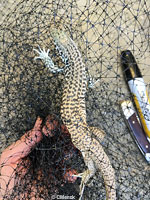 |
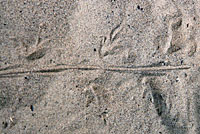 |
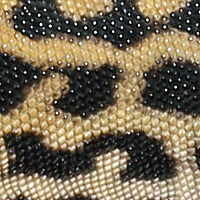 |
|||||||||||||||||||||||||||||||||||||||||||||||||||||
| CMenck found this adult trapped in some synthetic netting that was accidentally left on the ground in her L.A. County desert yard. After cutting it out of the net, it went on its way and the net was removed. | Whiptail Tracks in sand | Whiptails, genus Aspidoscelis, have small granular dorsal scales. | |||||||||||||||||||||||||||||||||||||||||||||||||||||
| Juveniles | |||||||||||||||||||||||||||||||||||||||||||||||||||||||
 |
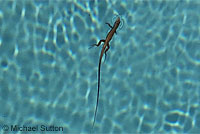 |
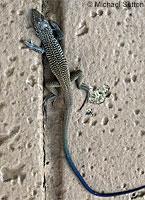 |
|||||||||||||||||||||||||||||||||||||||||||||||||||||
| Juvenile, Riverside County © Michael Sutton. This juvenile whiptail was discovered walking on the surface of the water in a swimming pool for about a minute before it started to sink. It was underwater for about 20 seconds before it was rescued. After about two minutes, it came back to life and ran away. |
|||||||||||||||||||||||||||||||||||||||||||||||||||||||
 |
|||||||||||||||||||||||||||||||||||||||||||||||||||||||
| Tiny juvenile, aprox. 2 inches long snout-to-vent, Imperial County © Karyn Sieglitz | |||||||||||||||||||||||||||||||||||||||||||||||||||||||
| Great Basin Whiptails From Outside California | |||||||||||||||||||||||||||||||||||||||||||||||||||||||
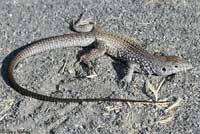 |
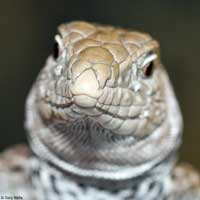 |
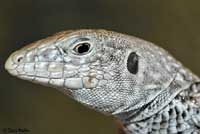 |
 |
||||||||||||||||||||||||||||||||||||||||||||||||||||
| Adult, Washoe County, Nevada | |||||||||||||||||||||||||||||||||||||||||||||||||||||||
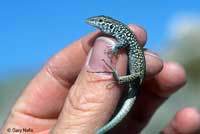 |
|||||||||||||||||||||||||||||||||||||||||||||||||||||||
| Juvenile, Washoe Co., Nevada | |||||||||||||||||||||||||||||||||||||||||||||||||||||||
| Predation | |||||||||||||||||||||||||||||||||||||||||||||||||||||||
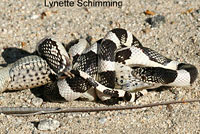 |
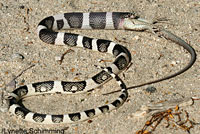 |
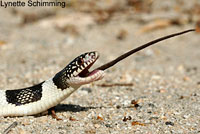 |
|||||||||||||||||||||||||||||||||||||||||||||||||||||
| A Long-nosed Snake eating a Great Basin Whiptail © Lynette Schimming. | |||||||||||||||||||||||||||||||||||||||||||||||||||||||
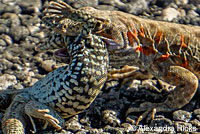 |
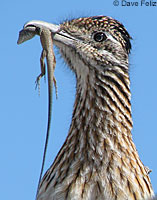 |
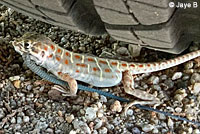 |
|||||||||||||||||||||||||||||||||||||||||||||||||||||
| Adult Long-nosed Leopard Lizard eating a Great Basin Whiptail on a road in San Bernardino County. (It is not known if the whiptail was killed by the leopard lizard or if it was dead before it was consumed. © Alexandra Hicks |
A Greater Roadrunner with a freshly killed Great Basin Whiptail in San Bernardino County. © Dave Feliz You can also watch a short YouTube video of this bird perched on top of a bush with the lizard in its beak as it sings. After singing it flew down to its nest in a cholla cactus where it probably fed the whiptail to its young. |
This juvenile Long-nosed Leopard Lizard is eating a juvenile Great Basin Whiptail in Inyo County. Swallowing the complete tail is probably going to take some time. © Jaye B |
|||||||||||||||||||||||||||||||||||||||||||||||||||||
| Habitat | |||||||||||||||||||||||||||||||||||||||||||||||||||||||
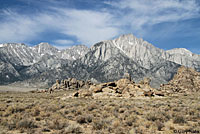 |
 |
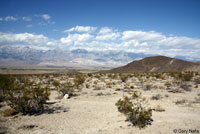 |
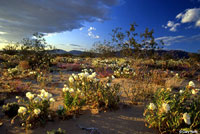 |
||||||||||||||||||||||||||||||||||||||||||||||||||||
| Habitat, Inyo County | Habitat, San Diego County |
Habitat, Inyo County | Habitat during Spring wildflower bloom, San Diego County | ||||||||||||||||||||||||||||||||||||||||||||||||||||
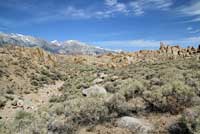 |
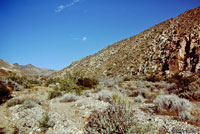 |
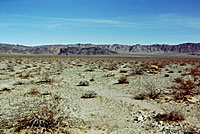 |
 |
||||||||||||||||||||||||||||||||||||||||||||||||||||
| Habitat, Inyo County | Habitat, San Bernardino County | Habitat, Riverside County |
Habitat, Imperial County desert |
||||||||||||||||||||||||||||||||||||||||||||||||||||
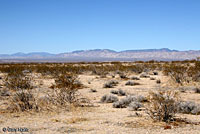 |
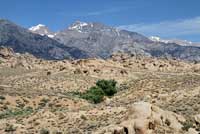 |
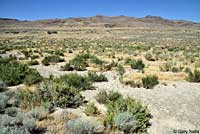 |
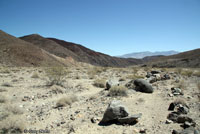 |
||||||||||||||||||||||||||||||||||||||||||||||||||||
| Habitat, Kern County |
Habitat, Inyo County | Habitat, Great Basin desert, 4,000 ft., Lassen County |
Habitat, rocky wash, Inyo County | ||||||||||||||||||||||||||||||||||||||||||||||||||||
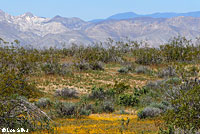 |
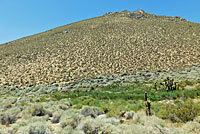 |
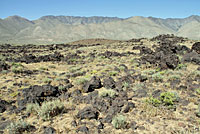 |
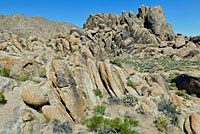 |
||||||||||||||||||||||||||||||||||||||||||||||||||||
| Habitat in Spring, Kern County © Lou Silva |
Habitat, Kern County | Habitat, Inyo County | Habitat, Inyo County | ||||||||||||||||||||||||||||||||||||||||||||||||||||
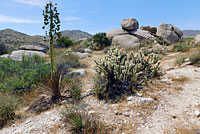 |
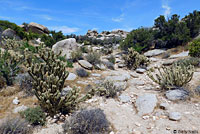 |
||||||||||||||||||||||||||||||||||||||||||||||||||||||
| Habitat, San Diego County | Habitat, San Diego County | ||||||||||||||||||||||||||||||||||||||||||||||||||||||
| Short Videos | |||||||||||||||||||||||||||||||||||||||||||||||||||||||
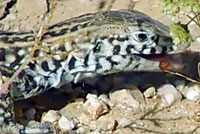 |
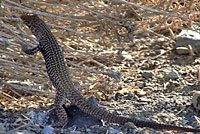 |
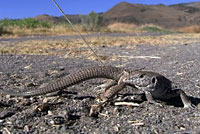 |
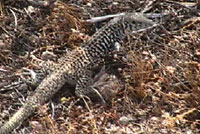 |
||||||||||||||||||||||||||||||||||||||||||||||||||||
| A Great Basin Whiptail in the Kern County Mohave Desert digs around looking for food, then eats a red ant, but has trouble with it. | A Great Basin Whiptail climbs up into a desert shrub to search for food. | A noosed whiptail is released, but decides not to move until prodded and then it disappears in a flash. | Views of a couple of Great Basin Whiptails in the desert. | ||||||||||||||||||||||||||||||||||||||||||||||||||||
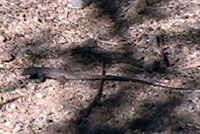 |
|||||||||||||||||||||||||||||||||||||||||||||||||||||||
| Two Great Basin Whiptails forage along the ground and on a rock outcrop with their characteristic slow and jerky movement. |
|||||||||||||||||||||||||||||||||||||||||||||||||||||||
|
|||||||||||||||||||||||||||||||||||||||||||||||||||||||
|
|||||||||||||||||||||||||||||||||||||||||||||||||||||||
|
The following conservation status listings for this animal are taken from the April 2024 State of California Special Animals List and the April 2024 Federally Listed Endangered and Threatened Animals of California list (unless indicated otherwise below.) Both lists are produced by multiple agencies every year, and sometimes more than once per year, so the conservation status listing information found below might not be from the most recent lists. To make sure you are seeing the most recent listings, go to this California Department of Fish and Wildlife web page where you can search for and download both lists: https://www.wildlife.ca.gov/Data/CNDDB/Plants-and-Animals. A detailed explanation of the meaning of the status listing symbols can be found at the beginning of the two lists. For quick reference, I have included them on my Special Status Information page. If no status is listed here, the animal is not included on either list. This most likely indicates that there are no serious conservation concerns for the animal. To find out more about an animal's status you can also go to the NatureServe and IUCN websites to check their rankings. Check the current California Department of Fish and Wildlife sport fishing regulations to find out if this animal can be legally pursued and handled or collected with possession of a current fishing license. You can also look at the summary of the sport fishing regulations as they apply only to reptiles and amphibians that has been made for this website. This animal is not included on the Special Animals List, which indicates that there are no significant conservation concerns for it in California. |
||
| Organization | Status Listing | Notes |
| NatureServe Global Ranking | ||
| NatureServe State Ranking | ||
| U.S. Endangered Species Act (ESA) | None | |
| California Endangered Species Act (CESA) | None | |
| California Department of Fish and Wildlife | None | |
| Bureau of Land Management | None | |
| USDA Forest Service | None | |
| IUCN | ||
|
|
||
Return to the Top
© 2000 -


